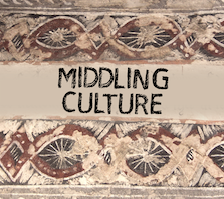
Cast-iron firebacks were produced in England from the first half of the sixteenth century and served to protect the back of chimneys and reflect heat back into the room. As domestic buildings increasingly incorporated chimneys these functional accessories were in demand and gradually the plain iron plates were embellished with imagery, including heraldry and biblical subject matter.[1]Among the collection of iron firebacks at Anne of Cleve’s House in Lewes, Sussex, is a personalised fireback dated 1636 depicting Richard Lenard, who succeeded his father as tenant of the iron foundry at Brede in 1605.[2]
This object is a form of annotated portrait – Lenard stands in the centre of the composition with a hammer in his hand and along the top rim are the words RICHARD LENARD FOVNDER AT BRED FOURNIS. Museum listings usually describe this object as representing ‘the tools of his trade’ but Lenard’s fireback is not simply an advertisement of his trade; the imagery appears to place his identity between the spheres of domestic and business interests.
On the right-hand side of the panel is depicted an ornate fireplace complete with its own fireback (with his initials R. L.) and a display of drinking vessels above. A faithful dog leaps to greet his owner.
On the left-hand side are the tools of Lenard’s business operation; a brick furnace with a wheelbarrow above containing charcoal and, in the top left-hand corner, a shield bearing a blacksmith’s hammer, bell and andiron.
Lenard straddles these spheres dressed in what appears to be a nightgown, with its tie and lace collar – a garment worn in the evenings by those who had access to leisure time. There is a striking incongruity in the combined accoutrements of robe and hammer but this meeting of symbols represents Lenard’s self-fashioned identity as that of a well-to-do member of society, proud to exhibit the skills of his trade but equally keen to signal the range of quality possessions furnished by his successful business. This seemingly humble object employs a common language of visual signifiers, such as trade tools, high-status domestic objects and distinctive clothing, which were also used in heraldry as bearings to identify the social rank and qualities of armigerous individuals or institutions.
This pseudo-heraldic personal emblem constructs a social identity for Lenard that cannot be defined as distinctively commercial or domestic in nature, but encompasses both. This fluidity and inter-dependence between spheres may be considered a defining characteristic of middling identity and culture – Lenard exhibits pride here in the mastery of his craft that contributes to the quality of his clothing and domestic furnishings. But at the same time his social status could augment the desirability of his products. The goods he creates and sells are themselves domestic objects placed at the heart of the home, the hearth, with opportunity for bespoke designs – initials, dates and imagery – to reflect and construct individual and social identities within a shared culture of objects and symbols. Presumably this particular demonstration of the products that could be crafted at Brede would have appealed to other middling tradesmen who fashioned themselves in terms of lifestyle as much as occupation.
This is a revised except from ‘Visual Culture’ in Andrew Hadfield, Matthew Dimmock and Abigail Shinn (eds), The Ashgate Research Companion to Popular Culture in Early Modern England (Ashgate, 2014).
[1]Jeremy Hodgkinson, British Cast Iron Firebacks of the 16th to mid 18th centuries(Crawley: Hodgers Books, 2010).
[2]Several versions of this fireback design are recorded, some more degraded than others; it was copied throughout the nineteenth century. There are other versions in the V&A and the Geffrye Museum.


A point worth noting is that Richard Lenard would have had to commission a wood carver to produce the model or pattern from which his fireback was cast. Stylistically this was probably the work of an otherwise unidentified carver whose initials, IM, are seen on other contemporary firebacks and whose work extended to the patterns for some iron graveslabs in the church at Wadhurst in Sussex. To have commissioned such a work, I wonder if Lenard was demonstrating a pride that could have been a challenge to a growing atmosphere of Puritan piety. Wealden parishes, and Brede was no exception, were no strangers to non-conformity.
LikeLike
Many thanks for your comments, Jeremy, and I’m very much indebted to your work on the range of firebacks of the period. Yes, the relationships between and across crafts is something we are keen to investigate in this project – wood carvers would also have created moulds for decorative plasterwork so there is certainly an element of collaboration. Your comment about Lenard’s fireback demonstrating a pride that could have been a challenge to a growing atmosphere of Puritan piety in the area is intriguing – not sure there’s anything here that would be offensive to stricter Protestants?
LikeLike